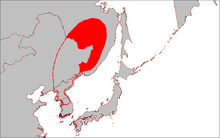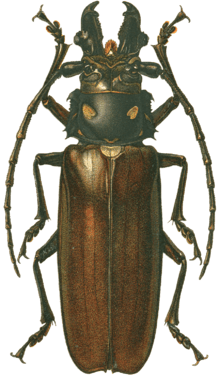Callipogon relictus
Callipogon relictus is a species of longhorn beetle which is mostly found in Korea, but also in China and southern part of Russian Far East.[2][3] It inhabits mixed and deciduous forests.[4] The population of Callipogon relictus is decreasing due to deforestation and uncontrolled collection, and therefore the species are listed in the Russian Red Book (category II).[5]
| Callipogon relictus | |
|---|---|
| Scientific classification | |
| Kingdom: | |
| Phylum: | |
| Class: | |
| Order: | |
| Family: | |
| Subfamily: | |
| Genus: | |
| Species: | C. relictus |
| Binomial name | |
| Callipogon relictus (Semenov 1898) [1] | |
 | |
The larvae of Callipogon relictus develop in the drying deciduous trees. The process takes 4 to 6 years, and the same tree can be populated by larvae several times a year.[4] Larvae bring along spores of the fungus Pleurotus citrinopileatus,[4] that contributes to degradation of the tree. With the length reaching up to 110 mm (4.3 in), Callipogon relictus is the largest beetle of Russia.[6][7][8][5] Larvae of different longhorn beetles can coexist in the same tree, such as Callipogon relictus, Rosalia coelestis, Leptura thoracica, Rhabdoclytus acutivittis, Anoplodera cyanea and several other species.[4]
Systematics
The beetle is a relict and the sole representative of the tropical genus Callipogon in the fauna of the Old World – other species of this genus inhabit Central and South Americas.[9] The divergence between Callipogon relictus and other species in the genus is estimated to have occurred around 34 million years ago, around the Eocene/Oligocene boundary, during the Early Eocene Climatic Optimum.[10] Callipogon relictus was described in 1898 by the Russian entomologist Andrey Semyonov-Tyan-Shansky (who wrote his last name as Semyonov until 1906). He distinguished the new species from the other species of the genus by the following features:[1][9]
- Extended rear part, that makes antennae shorter relative to the body size,
- Shorter and almost hairless upper jaws
- Edges of the prothorax are not jagged but bear spines,
- Eyes are closer together.
These features were later interpreted as a sign of higher evolutionary development of Callipogon relictus compared to other species of its genus,[9] but a more recent phylogenetic study found that the species is nested within the phylogeny of the genus, being closely related to species found from Colombia to Mexico.[10]
Distribution
In Russia Callipogon relictus inhabits Amur Oblast, to the south and south-east of the town Raychikhinsk. It is also common in the Khingan and Norsk reserves, in the south of Khabarovsk Krai (south from Khabarovsk city), Jewish Autonomous Oblast and Primorsky Krai. The northernmost observation was reported near the village of Ekimchan in Amur Oblast.[4][9] Outside Russia the beetle occurs in Northeast China, North Korea and South Korea.[11][12][13] It is expected that its distribution will increase to the north with climate change.[10]
Description
Adults

Developed body (imago) is black, with brown elytra and brown-black feet;[4] there are two pairs of bright spots of hair on pronotum.[14] The size and shape of jaws and antennae varies among individuals.[9] Antennae are dotted and rather long. Their first segment is short and thickened. The third segment is extended and is longer than the fourth and fifth segments combined. The fourth segment is equal or slightly longer than the fifth, and the 11th segment is longer than the first. The lower parts of third to tenth segments have spines.[9]
Mandibles are two-toothed and are very large in males, longer than the head; they are much shorter in females. The upper side of the jaw is covered with coarse, wrinkled punctation, and the lower jaw and lower lip have thick shaggy orange felt. Pronotum is convex, with narrow spines on its sides; the spines are longer in females than males. Scutellum is densely covered with yellowish hairs. Elytra are very long, spotted and rounded at their top; they are more shining in males than in females.[4][9]
Larvae, egg and pupa
Larvae are white, with black mandibles; the front half of pronotum has a transverse red stripe, which can have four narrow grooves. Larval body is massive, yellowish-white and covered with sparse, fine yellowish hairs. The head is strongly retracted into prothorax, epistoma is well delimited. Frontal sutures are distinct, longitudinal edges are sharply defined. Hypostome consists of two longitudinal sclerites, which are moved apart by the protruding regularly plate. Clypeus is small, transverse, whitish. Pronotum covers much of the head. The shield of protonum is smooth at its front, and its back is densely covered with wrinkles. Thoracic legs are short, with long claws, covered with thick bristles.[4][9][15]
The egg has an oval shape and is 6–7 mm (0.24–0.28 in) long. It is pink in the early stage, then darkens and turns black. The chorion of the egg has deep, thick, slightly faceted cells. The gaps between the cells are smaller than the cells themselves.[4]
Pupa has a sturdy body, antennae are pressed to the sides. A narrow longitudinal groove runs in the middle of pronotum. Abdomen is broad, strongly narrowed to the top. Abdominal tergites are protruding and covered in short thick spines.[4]
Lifestyle
Callipogon relictus inhabits mixed and deciduous forests.[12] It is unknown whether it inhabits temperate coniferous forests, but the beetles were sometimes found in coniferous plantations. Larva feeds on rotten wood, and the adults drink juice, which protrudes from the trunks of linden, elm and other trees. In captivity, one female could drink up to 0.5 millilitres (0.018 imp fl oz; 0.017 US fl oz) of sugar syrup at once. Adults are active during the day; in the night they fly to the light sources. During the day, females fly more than males and therefore are encountered more frequently.[4]
Larvae develop in such trees as Japanese elm, Manchurian Ash, Tilia amurensis and Populus maximowiczii; they rarely occupy Mongolian oak, sawtooth oak, Siberian elm, Japanese elm, Betula costata, Carpinus laxiflora and Manchurian maple.[4][12][13][15][16][17]
Entomopathogenic fungus of the form Metarhizium anisopliae (Clavicipitaceae family) is deadly for a variety of insects, including the adult Callipogon relictus.[18]
Reproduction
Females reach a length of 58–85 mm (2.3–3.3 in), and the males are 60–110 mm (2.4–4.3 in) long.[9] Females emit a special secretion to attract a partner. Mating occurs on the tree which serves as a feeding ground for larvae, below the place where the female will lay eggs; copulation lasts up to an hour. After mating the male does not leave female. Instead, he places front legs on the elytra of the female and they together climb the tree up to where the female will lay eggs. Eggs are laid by one or in groups on the bark of trees with a trunk diameter of 30–100 cm (12–39 in). Over a lifetime (adult beetles live up to a month), a female can produce up to 28 eggs. After the female has laid eggs, the couple crawls down tree and dies on the ground.[4][12]
Newborn larvae dig under the bark making corridors up to 40 cm (16 in) long and 2 cm (0.79 in) wide. They then delve into wood to a depth of 5 to 30 cm (2.0 to 11.8 in) creating a network of tunnels there. One tree is re-populated several times and therefore usually contains larvae of different ages; only completely dried out trees are suitable for larva development. If a dry tree branch breaks from the tree with the larvae inside, the larvae stays inside the branch, but produces smaller adults than usual. Larvae live through 4–6 winters. After the last overwintering, they make large cradles (100–150 mm, 4–6 in) oriented perpendicular to the trunk, separated from the tree surface by about 2 cm (0.79 in). Then the larva turns in the cradle with its head toward the trunk surface and pupates. Pupation occurs in June–July during 20–35 days and the pupa growth up to 70–110 cm (28–43 in) long. Females exit cradles a few days before males.[12]
In popular culture
In 1911–1913, the Russian entomologist O. I. Ion wrote a satirical poem "Importunate insects" (Russian: Назойливое насекомое), dedicated to Andrey Semyonov-Tyan-Shansky and Callipogon relictus, the longhorn beetle he described .[19] Callipogon relictus is also depicted on the badge of the Ussuri Reserve.[20]
References
- Semenov, A. (1898). "Callipogon (Eoxenus) relictus sp. n., Vertreter des neotropischen Genus der Cerambyciden in der russischen Fauna". Horae Soc. Ent. Ross. 32: 562–580.
- Захаров, A. A. (2000). Dictionary of animal names in five languages. Russo. p. 149. ISBN 978-5-88721-162-6. Retrieved 15 February 2011.
- Robert Perger. "Callipogon relictus". Coleop-Terra Catalogue. Archived from the original on 8 July 2011. Retrieved 5 October 2010.
- Черепанов А. И. (1979). Усачи Северной Азии (Prioninae, Disteniinae, Lepturinae, Aseminae). I. Novosibirsk: Nauka. pp. 48–51.
- Никитский Н.Б. "Реликтовый дровосек – Callipogon relictus Semenov, 1898". Красная книга (in Russian). sevin.ru. Retrieved 6 January 2011.
- Aleksandr Mikhaĭlovich Prokhorov (1982). Great Soviet encyclopedia. Macmillan.
- Никитский Н.Б. "Реликтовый дровосек Callipogon relictus" (in Russian). feeco.narod.ru. Retrieved 5 January 2011.
- "Archived copy" Краевая независимая экологическая газета Свежий Ветер Приморья (PDF) (in Russian). 4 (20). 2009: 8. Archived from the original (PDF) on 30 August 2011. Retrieved 16 February 2011. Cite journal requires
|journal=(help)CS1 maint: archived copy as title (link) - Плавильщиков Н. Н. (1936). "1". In Зернов, С. А. (ed.). Фауна СССР. Насекомые жесткокрылые. Жуки-дровосеки. XXI. Moscow: Издательство Академии Наук СССР. pp. 66–68.
- Kim, S.; de Medeiros, B. A. S.; Byun, B. K.; Lee, Seunghwan; Kang, J. H.; Lee, B.; Farrell, B. D. (2018). "West meets East: How do rainforest beetles become circum-Pacific? Evolutionary origin of Callipogon relictus and allied species (Cerambycidae: Prioninae) in the New and Old Worlds". Molecular Phylogenetics and Evolution. 125: 163–176. doi:10.1016/j.ympev.2018.02.019. PMID 29524651.
- Byun, BK et al. (2006). Research Report on a Natural Monument, Callipogon relictus Semenov in the Gwangneung Forest, Korea. Korea National Arboretum. p. 46
- Куприн, Александр Витальевич. "Section Антропология. Репродуктивное поведение имаго реликтового усача (Callipogon relictus Sem.). p. 124" (PDF) (in Russian): 4–322. Archived from the original (PDF) on 8 February 2012. Retrieved 16 February 2011. Cite journal requires
|journal=(help) - B. K. Byun; G. J. Weon; D. G. Jo; et al. (2007). "광릉숲에서의 장수하늘소(딱정벌레목; 하늘소과) 서식실태 조사결과 및 보전을 위한 제언" [Occurrence of Callipogon relictus Semenov (Coleoptera: Cerambycidae) in the Gwangneung Forest, Korea with Suggestions for the Conservation]. Korean Journal of Applied Entomology. 46 (1): 19–25. doi:10.5656/KSAE.2007.46.1.019. ISSN 1225-0171.
- П. А. Лер, ed. (1996). Определитель насекомых Дальнего Востока СССР. III. Жесткокрылые, или жуки. part.3. Vladivostok: Дальнаука. p. 69.
- Ильинский А. И., ed. (1962). Определитель вредителей леса. Moscow: Сельхозиздат. p. 298.
- "Invasive Plants Established in the United States that are Found in Asia and Their Associated Natural Enemies. Ulmus pumila Siberian elm" (PDF). II: 139–150. Cite journal requires
|journal=(help) - "Invasive Plants Established in the United States that are Found in Asia and Their Associated Natural Enemies. Quercus acutissima Sawtooth oak" (PDF). II: 66–86. Cite journal requires
|journal=(help) - Maljarchuk A. A.; Shternshis M. V. (2007). "Spontaneous Variability of Metarhazium anisopliane(Metsch.) Sor. Strains as an Approach for Enhancementof Insecticidal Activity" (PDF). 44. Novosibirsk: Национален център за аграрни науки: 236–239. Journal name (alt language): Растенивъдни науки. Archived from the original (PDF) on 27 July 2011. Cite journal requires
|journal=(help) - "А. П. Семенов-Тян-Шанский и Callipogon relictus в поэтической сатире" (in Russian). ZIN.ru. Retrieved 5 January 2011.
- Берлов, Олег. "Усач Callipogon relictus на значке Уссурийского заповедника" (in Russian). ZIN.ru. Retrieved 5 January 2011.
External links
| Wikispecies has information related to Callipogon relictus |